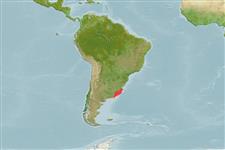Common names from other countries
>
Clupeiformes (Herrings) >
Clupeidae (Herrings, shads, sardines, menhadens)
Etymology: Ramnogaster: Greek, rhamnos, -on = blackberry + Greek, gaster = stomach.
More on author: Jenyns.
Environment: milieu / climate zone / depth range / distribution range
Ecologia
marinhas; intervalo de profundidade 0 - 50 m (Ref. 188). Subtropical; 33°S - 42°S, 64°W - 52°W (Ref. 188)
Southwest Atlantic: southern Brazil (estuary of the Lagoa dos Patos) and Uruguay to at least Bahía Blanca, Argentina; some of the more southerly records (even to the Beagle Channel) must refer to Sprattus fuegensis.
Tamanho / Peso / Idade
Maturity: Lm ? range ? - ? cm
Max length : 9.0 cm SL macho/indeterminado; (Ref. 188); common length : 7.5 cm SL macho/indeterminado; (Ref. 188)
Descrição breve
Chaves de identificação | Morfologia | Morfometria
Espinhos dorsais (total) : 0; Raios dorsais moles (total) : 18 - 19; Espinhos anais: 0; Raios anais moles: 12 - 23. Belly sharply keeled. Flanks silvery without a distinct silver stripe (cf. Platanichthys). Distinguished from R. melanostoma of freshwaters by having more dorsal and pectoral fin rays and total gill rakers; from small Sardinella and Harengula by the evenly rounded hind margin of the gill opening; and from Sprattus fuegensis by having i 6 pelvic fin rays.
Forms schools in coastal waters, apparently inshore but not entering freshwater.
Life cycle and mating behavior
Maturities | Reprodução | Spawnings | Egg(s) | Fecundities | Larvas
Whitehead, P.J.P., 1985. FAO Species Catalogue. Vol. 7. Clupeoid fishes of the world (suborder Clupeoidei). An annotated and illustrated catalogue of the herrings, sardines, pilchards, sprats, shads, anchovies and wolf-herrings. FAO Fish. Synop. 125(7/1):1-303. Rome: FAO. (Ref. 188)
Categoria na Lista Vermelha da IUCN (Ref. 130435)
CITES (Ref. 128078)
Not Evaluated
Ameaça para o homem
Harmless
Utilização humana
Pescarias: pouco comercial
Ferramentas
Relatórios especiais
Descarregue XML
Fontes da internet
Estimates based on models
Preferred temperature (Ref.
115969): 11.7 - 18.3, mean 15.7 (based on 74 cells).
Phylogenetic diversity index (Ref.
82804): PD
50 = 0.7500 [Uniqueness, from 0.5 = low to 2.0 = high].
Bayesian length-weight: a=0.00708 (0.00349 - 0.01438), b=3.11 (2.93 - 3.29), in cm Total Length, based on LWR estimates for this (Sub)family-body shape (Ref.
93245).
Nível Trófico (Ref.
69278): 3.1 ±0.1 se; based on size and trophs of closest relatives
Resiliência (Ref.
120179): Elevada, tempo mínimo de duplicação da população menor que 15 meses (Preliminary K or Fecundity.).
Fishing Vulnerability (Ref.
59153): Low vulnerability (10 of 100).
